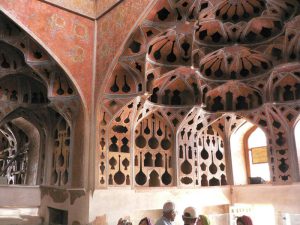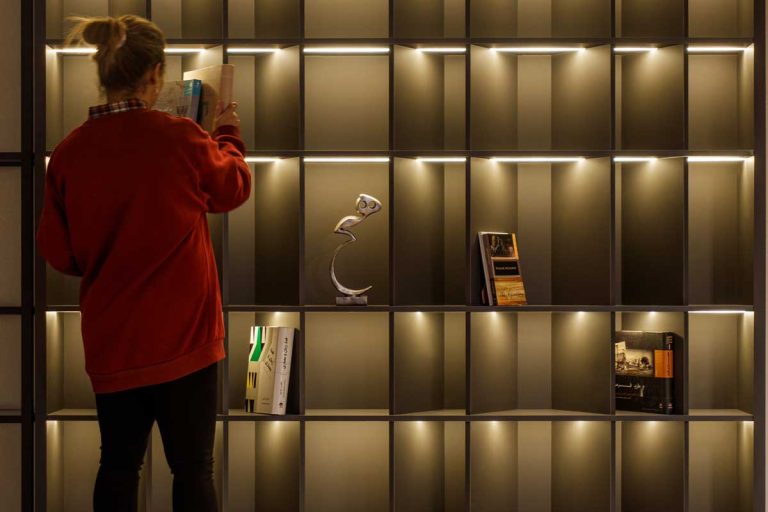نوع مقاله : مقالۀ پژوهشی
نویسندگان
- فاطمه نوری 1
- محمدمهدی سروش 2
- منوچهر فروتن 2
- حمیدرضا شعیری 3
1 دانشجوی دکتری معماری، گروه معماری، واحد همدان، دانشگاه آزاد اسلامی، همدان، ایران.
2 استادیار گروه معماری، واحد همدان، دانشگاه آزاد اسلامی، همدان، ایران.
3 استاد گروه زبان فرانسه، دانشکدة علوم انسانی، دانشگاه تربیت مدرس، تهران، ایران.

باغ نظر (ماهنامه)
دوره 18، شماره 98
مرداد 1400
صفحه 106-95
بیان مسئله: شعر و معماری بهعنوان دو شاخة هنری جهت انتقال پیام، زبان و ابزار خاص خود را به کار میبرند. هر یک از دو هنر مذکور با ابزاری که در اختیار دارند فضایی را ایجاد میکنند که توسط مخاطب قابلخوانش است. این ویژگی (خوانشپذیری) آنها را به سمت متنبودگی سوق میدهد. شاعرانگی یا بوطیقا واژهای است برای نشاندادن زیباییشناسی تکوینی، عناصر کیفی فضا و ساختن در هنرها که همچون زیرساختی است که با گذر از ویژگیهای متنبودگی اتفاق میافتد و موجب ارتقای کلام به شعر و به همین ترتیب موجب تمایز بین ساختمانسازی از دنیای معماری میشود. راهبردهای شاعرانگی در شعر توسط فنون ادبی مختلفی شناسایی و دستهبندیشدهاند.
اهداف پژوهش: هدف تحقیق حاضر آن است که با بررسی و تطبیق شاعرانگی در فضای شعر با معماری، عناصر و راهبردهای شاعرانگی در فضای معماری را کشف کند و به این پرسش پاسخ دهد که چه شباهتهایی در فنون ادبی شعر و راهبردهای معماری وجود دارد که موجب شاعرانهشدن فضا در شعر و معماری میشود؟
روش پژوهش: در این راستا از معماری معاصر مذهبی بهره گرفته شده است، چرا که در معماری مذهبی علاوه بر کارکرد، بیان مفاهیم نیز اهمیت دارد و بستر مناسبی برای بیان شاعرانه در معماری فراهم میکند. بناهای انتخابی از بین بناهای مذهبی و از ادیان مختلف برگزیده شده است. نمونههای موردی بررسی شامل «معبد آب» اثر «تادائو آندو»، «نمازخانة پارک لاله» اثر «کامران دیبا»، «مسجد سانجاکلار» اثر «امره آرولات» و «کلیسای سان جیو وانی» اثر «ماریو بوتا» است. نخست، زیرساختهای مشترک میان معماری و شعر گفته شده است؛ سپس، زبان بهعنوان عامل مشترک بین دو هنر شناختهشده و مبنایی جهت تطبیق آنها قرار گرفته است.
نتیجهگیری: «بوطیقا» بهعنوان محور بحث شده و در نهایت بررسیها نشان داد که معماران نیز همچون شاعران با فنون ادبی مانند تلمیح، حسآمیزی، آشناییزدایی، استعاره و مجاز به ایجاد معماری شاعرانه پرداختهاند.
Architecture Poetics in Some Selected Religious Contemporary Architecture Works: The Comparative Study of Poetics Capabilities in Poetry and Architecture
نویسندگان [English]
- Fatemeh Nouri 1
- Mohammad Mahdi Soroush 2
- Manouchehr Foroutan 2
- Hamid Reza Shairi 3
Poetry and architecture as two artistic branches use their own language and instrument to convey message. Each of the mentioned arts creates a space by their instruments which is readable by the audience. This property (readability) push them towards textuality. Poetics is a word to show generative aesthetics, space qualitative elements and construction in arts. The infrastructure which happens by passing through textuality properties and promotes speech to poem and also distinguishes between construction and architecture world. Poetic strategies have been identified and classified in poetry by different literary techniques. The current study aims at exploring poetic elements and strategies in architecture space by investigating and comparing poetics in the space of poetry with architecture and answers this questions that what similarities in poetry literary techniques and architecture strategies make the space in poetry and architecture poetic? Therefore, religious contemporary architecture has been used as besides function, expressing concepts is also important in religious architecture which provides a suitable background for poetic expression in architecture. The selected buildingsa have been chosen among religious buildings and from different religions. The samples under investigation are The Water Temple by Tadao Ando, Laleh Park Chapel by Kamran Diba, Sancaklar Mosque by Emre Arolat and Church of San Giovanni Battista by Mario Botta. First, common infrastructures between architecture and poetry have been mentioned. Language has been considered as common factor between these two arts and has been regarded as a basis to compare them. “Poetics” as the axis of this discussion and finally investigations showed that architects like poets have created poetics architecture by literary techniques such as allusion, synesthesia, defamiliarization, metaphor and trope.
بوطیقای معماری در چند اثر منتخب مذهبی معاصر مطالعة تطبیقی قابلیتهای شاعرانگی در شعر و معماری اصل مقاله 2.12 MB
صاحب امتیاز: پژوهشکده هنر، معماری و شهرسازی نظر
مدیر مسئول: دکتر سید امیر منصوری
سردبیر: دکتر احمد پوراحمد
دوره انتشار: ماهنامه
شاپا چاپی: 1735-9635
شاپا الکترونیکی: 2251-7197





















